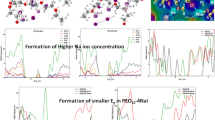Abstract
Density functional theory was used for a quantum chemical study of oligo[methyl(phenyl)silylene] structures containing a conformational defect: a kink in the silicon backbone. Oligomers were studied in the neutral state as well as in the form of positive (P+) and negative (P−) polaron quasiparticles. Computations performed using the B3LYP model and the 6-31G(d) basis set revealed that the charge distribution is not influenced by the presence of the kink, but the positive charge on the Si backbone differs slightly in P+ and P− quasiparticles. On the other hand, the spin density is significantly shifted away from the chain part that contains the kink, and this effect is more intense in P− polarons. Changes in electron density are also evident from the frontier molecular orbital distribution. The deformation energy (which is associated with the relaxation of polarons) decreases with the number of atoms in the oligomer backbone in P+ but shows the opposite behavior for P− quasiparticles.










Similar content being viewed by others
References
Demchenko YV, Klimovic J, Nespurek S (2004) Optical spectroscopy of poly silylene films. Macromol Symp 212:461–466
Nespurek S, Wang G, Yoshino K (2005) Polysilanes—advanced materials for optoelectronics. J Optoelectron Adv M 7:223–230
Semenov VV (2011) Preparation, properties and applications of oligomeric and polymeric organosilanes. Russ Chem Rev 80:313–339
Mark JE, Allcock HR, West R (2005) Inorganic polymers. Oxford University Press, New York
Michl J, West R (2000) Conformations of linear chains. Systematics and suggestions for nomenclature. Acc Chem Res 33:821–823
Fogarty HA, Ottosson C-H, Michl J (2000) The five favoured backbone conformations of n-Si4Et10: cisoid, gauche, ortho, deviant and transoid. J Mol Struct THEOCHEM 506:243–255
Fujiki M (2003) Switching handedness in optically active polysilanes. J Organomet Chem 685:15–34
Karatsu T (2008) Photochemistry and photophysics of organo monosilane and oligosilanes: updating their studies on conformation and intermolecular interactions. J Photochem Photobiol C 9:111–137
Hanulikova B, Kuritka I (2014) Manifestation of conformational defect on electronic spectra of polysilanes—a theoretical study. Macromol Symp 339:100–111
Nozar J, Nespurek S, Sebera J (2012) Polaron binding energy in polymers: poly[methyl(phenyl)silylene]. J Mol Model 18:623–629
Toman P, Nespurek S, Jang JW, Lee CE (2002) Conformation changes of polysilanes during the polaron formation. Curr Appl Phys 2:327–330
Nespurek S, Kochalska A, Nozar J, Kadashchuk A, Fishchuk II, Sworakowski J, Kajzar F (2010) Feature of polaronic charge carriers in polysilanes: experimental and theoretical approach. Mol Cryst Liq Cryst 521:72–83
Toman P (2000) Quasiparticle in σ-conjugated polymers. Synth Met 109:259–261
Nespurek S, Nozar J, Kadashchuk A, Fishchuk II (2009) Polaronic transport in polysilanes. J Phys Conf Ser 193:012108
Nespurek S, Kadashchuk A, Fishchuk II, Arkhipov VI, Emelianova EV (2005) Polarons in polysilanes: theoretical background and experimental detection. In: Proc Int Symp Electrets (ISE-12), Salvador, Brazil, 11–14 Sept 2005, pp 216–219
Nespurek S, Valerian V, Eckhardt A, Herden V, Schnabel V (2001) Charge carrier transport in poly[methyl(phenyl)silylene]: the effect of additives. Polym Adv Technol 12:306–318
Nespurek S, Eckhardt A (2001) Poly(silylene)s: charge carrier photogeneration and transport. Polym Adv Technol 12:427–440
Nespurek S, Sworakowski J, Kadashchuk A, Toman P (2003) Poly silylenes: charge carrier transport and photogeneration. J Organomet Chem 685:269–279
Nespurek S, Schauer F, Kadashchuk A, Fishchuk II (2007) Polarons in wide-band-gap molecular materials: polysilanes. J Non-Cryst Solids 353:4474–4478
Hehre WJ (2003) A guide to molecular mechanics and quantum chemical calculations. Wavefunction, Inc., Irvine
Shao Y, Molnar LF, Jung Y, Kussmann J, Brown ST, Ochsenfeld C, Gilbert ATB, Slipchenko LV, Levchenko SV, O’Neill DP, DiStasio RA Jr, Lochan RC, Wang T, Beran GJO, Besley NA, Herbert JM, Lin CY, Van Voorhis T, Chien SH, Sodt A, Steele RP, Rassolov VA, Maslen PE, Korambath PP, Adamson RD, Austin B, Baker J, Byrd EFC, Dachsel H, Doerksen RJ, Dreuw A, Dunietz BD, Dutoi AD, Furlani TR, Gwaltney SR, Heyden A, Hirata S, Hsu C-P, Kedziora G, Khalliulin RZ, Klunzinger P, Lee AM, Lee MS, Liang WZ, Lotan I, Nair N, Peters B, Proynov EI, Pieniazek PA, Rhee YM, Ritchie J, Rosta E, Sherrill CD, Simmonett AC, Subotnik JE, Woodcock HL III, Zhang W, Bell AT, Chakraborty AK, Chipman DM, Keil FJ, Warshel A, Hehre WJ, Schaefer HF, Kong J, Krylov AI, Gill PMW, Head-Gordon M (2006) Advances in methods and algorithms in a modern quantum chemistry program package. Phys Chem Chem Phys 8:3172–3191
Acknowledgments
This work was supported by the Internal Grant Agency of Tomas Bata University in Zlín (grant no. IGA/FT/2014/006). This paper was written with the support of the Operational Program Research and Development for Innovations, co-funded by the European Regional Development Fund (ERDF) and the national budget of the Czech Republic, within the framework of the Centre of Polymer Systems (reg. number: CZ.1.05/2.1.00/03.0111) project, and with the support of the Operational Program Education for Competitiveness, co-funded by the European Social Fund (ESF) and the national budget of the Czech Republic, within the framework of the Advanced Theoretical and Experimental Studies of Polymer Systems (reg. number: CZ.1.07/2.3.00/20.0104) project.
Author information
Authors and Affiliations
Corresponding author
Rights and permissions
About this article
Cite this article
Hanulikova, B., Kuritka, I. Theoretical study of polaron binding energy in conformationally disrupted oligosilanes. J Mol Model 20, 2442 (2014). https://doi.org/10.1007/s00894-014-2442-y
Received:
Accepted:
Published:
DOI: https://doi.org/10.1007/s00894-014-2442-y




